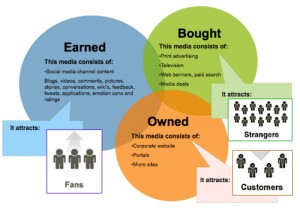 Measuring the return-on-investment for paid, earned, and owned media is not an easy task.
Measuring the return-on-investment for paid, earned, and owned media is not an easy task.
When I started my career, we measured media impressions and advertising equivalency. Somewhere along the way someone finally told the industry that was ridiculous and meant nothing.
So where did that leave us?
We know, intuitively, that paid, earned, and owned media increase brand awareness, unaided recall, and loyalty. But more and more business leaders are asking us to define that directly to hard, cold cash.
Forrester has a really simple chart that shows you the media type, definition, examples, the role, benefits, and challenges.
I’m not a paid media expert so I’ll leave that segment to those who are. But we can discuss earned and owned media, the ROI, and how to measure.
Earned Media
Earned media, according to Wikipedia is:
Favorable publicity gained through promotional efforts other than advertising. Earned media often refers specifically to publicity gained through editorial influence, whereas social media refers to publicity gained through grassroots action, particularly on the Internet. The media may include anymass media outlets, such as newspaper, television, radio, and the Internet, and may include a variety of formats, such as news articles or shows, letters to the editor, editorials, and polls on television and the Internet.
Earned media typically means, to those in the communication field, media relations.
It used to be that we’d spend our entire careers developing relationships with reporters, journalists, editors, and producers in order to have stories created that helped the companies with which we worked.
But with the technology age, traditional media outlets closed and the people we built spent our entire careers building relationships with were out of jobs.
Now we’re faced with continuing traditional media relations, but also building relationships with bloggers and social media influencers.
The cool thing? It’s much easier, now, to measure our earned media efforts.
For instance, consider creating an online media room. Use that URL in all your dealings with media, bloggers, and influencers. You’ll be able to track who is visiting the page, where they’re coming from, how long they’re staying, what they’re viewing, and whether or not they’re downloading information.
Based on that information, you can refine and improve your information and messages.
Not only does tracking this way provide you numbers to use when dealing with your executive team, but it also makes you really smart about the types of information to keep in the room.
Owned Media
Owned media, according to Forrester, is
A channel you control. There is fully-owned media (like your website) and partially-owned media (like Facebook fan page or Twitter account). Owned media creates brand portability. Now you can extend your brand’s presence beyond your web site so that it exists in many places across the web – specifically through social media sites and unique communities. In a recession in which marketing budgets are being cut by 20%, the ability to communicate directly with consumers who want to engage with your brand through long-term relationships can be invaluable.
I’m a big believer in having your owned media reside on something you own. And then lending your content and community to outlying networks, such as Twitter, Facebook, and Google+.
Content doesn’t have to be blogging, either. It can include white papers, eBooks, webinars, podcasts, video campaigns, and email marketing.
But the best (and most effective) way to measure your owned media is to provide calls-to-action. What do you want people to do after they’ve read, listened to, or watched your content?
For instance, we do a Facebook question of the week. People can ask me a question on our Facebook wall. I then answer it via video. That video is uploaded to YouTube, is featured here, and is also added to the Arment Dietrich home page.
The call-to-action on every video is for people to like the Arment Dietrich Facebook page and leave a question on the wall.
And then we measure not only how many questions we get, but how many video views, how many visitors to that particular blog post, how many comments, how many social shares, and more.
If you need the call-to-action to be monetary, think about what you want someone to do.
For instance, create a free webinar that teaches your prospects about a problem your company solves. In return for the free webinar, you have attendees’ permission to let your sales team follow-up with them.
Also be thinking about:
- A call-to-action on every piece of owned media you create.
- Landing pages where people download your content. Landing pages allow you to track the effectiveness of one particular piece of content.
- Registration (i.e. email address and phone number) in exchange for some piece of content.
- Building your database.
- Generating leads.
- Converting leads.
- Integrating your efforts with the sales team.
If you’re able to create a holistic approach with all of your media efforts, you’ll soon become the hub in the wheel of information where you’re looked at as an investment, not an expense.
This first ran as part of the Cision Future of Earned Media series